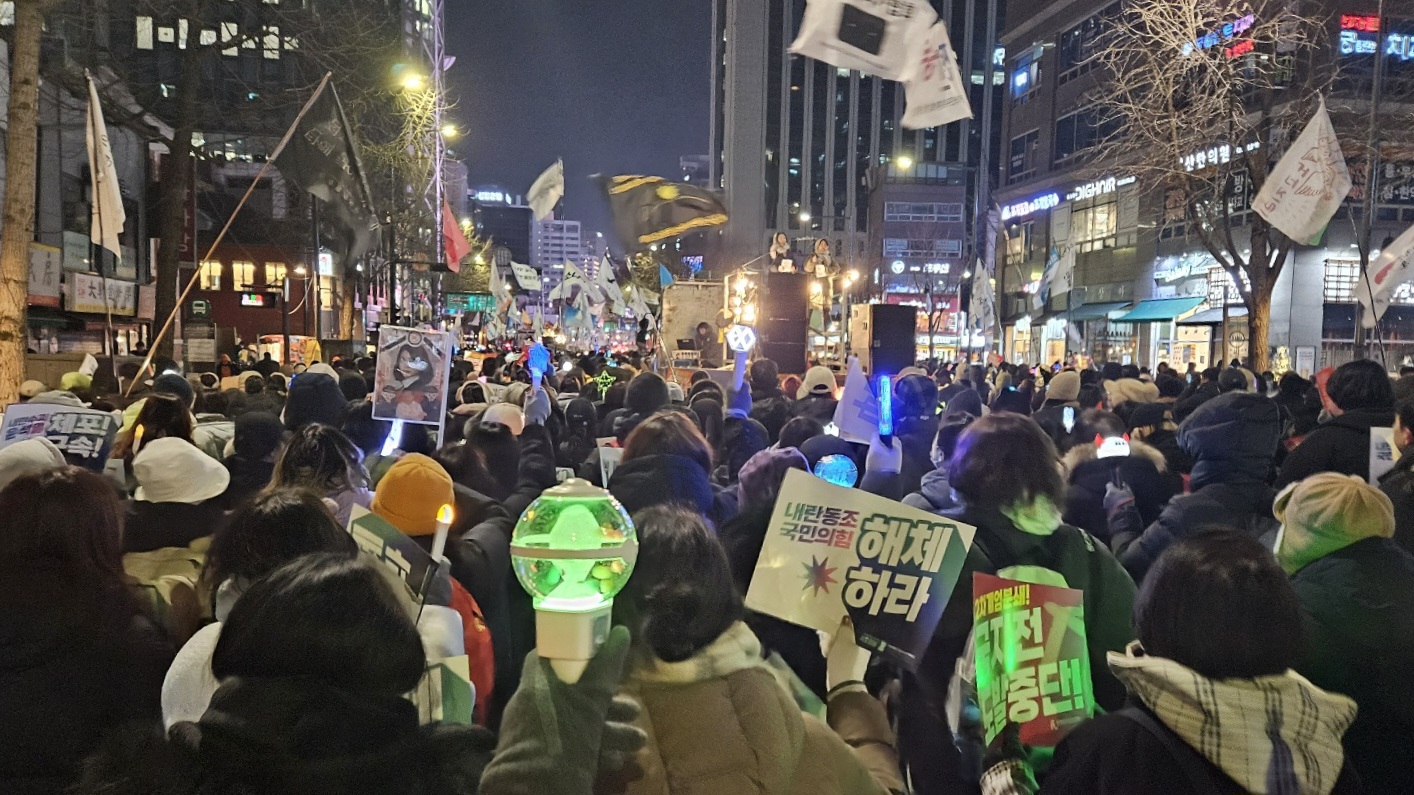
 ▲ Protesters waving their light sticks and flags at the rally, calling for the impeachment of Yoon
▲ Protesters waving their light sticks and flags at the rally, calling for the impeachment of Yoon
On December 3, 2024, the then-president of South Korea, Yoon Suk Yeol, declared martial law. Fortunately, just three hours after this shock announcement, the National Assembly passed a resolution to lift it. However, this brief but dramatic episode revealed the fragility of democracy under military enforcement and the potential for major suppression of free speech and other human rights. This was enough to leave citizens stunned and furious.
Hundreds of thousands of people joined a series of protests demanding Yoon's impeachment. Among the diverse participants, the crowd was largely made up of young people-a striking contrast to how youth are often portrayed in the media. The term 'MZ' combines Millennials and Gen Z, referring to today's young people. In the media, MZ generations are often described as apolitical, demanding, and lacking in responsibility. However, the gap between these characterisations and what we saw during the last few weeks raises an important question: Are young Koreans really apolitical and self-centered individualists?
Changes in Protest Culture
Although the declaration of martial law posed a serious challenge to Korea's democracy, it couldn't dampen the spirit of the protests. Instead, K-pop songs filled the air and the rallies resembled outdoor music festivals. While Korea has shown many peaceful protests in the past, this festive atmosphere was a new feature, reflecting shifts in protest culture. These changes were driven by young Koreans, who became a large part of the protest movement.
One notable change was the use of an upgraded version of candlelight: light sticks, commonly used for supporting K-pop artists at concerts. In the past, candles were symbols of peaceful resistance, especially for political expression at rallies in 2016 and 2017. However, in the recent protests, young generations familiar with K-pop culture waved customized light sticks in unison as they protested against Yoon and political misconduct.
The playlist of protest songs embraced not only folk songs but also K-pop hits. The crowd chanted 'Impeach Yoon Suk Yeo!' along with K-pop such as "Into the New World" and "Whiplash." In addition, flags featuring humor and satire helped protesters not to lose their smiles. Ingenious flags represented fictional organizations like "the Association of Workers' Lunch Menu Recommendations," "the National Union of Lying Down at Home," and "the Pizza Topping Research Group." These symbols signalled that the protest extended beyond a few traditional civic groups, reflecting the participation of everyday citizens.
Numerous ways have emerged for protesters to make their voices heard. Apart from attending the protest and singing along to the protest songs, countless people supported the movement indirectly. People who couldn't make it to the protest paid in advance for meals or drinks for protesters enduring the harsh winter. Protesters could warm themselves in cafes or restaurants with the bills already covered by anonymous supporters. Among the attendees, some brought their work, assignments, or homework, determined to support the protest while staying on top of their responsibilities. Although they didn't sing or chant and some couldn't even attend in person, their spirit and determination were still present in the crowd.
20s and 30s Women Stand at the Center of Resistance
According to Seoul Metropolitan Government data, women in their 20s and 30s made up the greatest portion of all the demographic groups in the protest. In many ways, it was not a huge surprise. Since his time as a presidential candidate, Yoon tried to abolish the Ministry of Gender Equality and Family, and explicitly cleaved to the opinion that there is no more gender inequality and discrimination. In this sense, the significant participation of young women in the recent protests is the culmination of their resistance against the authoritarian and anti-feminist Yoon administration. Moreover, as young women are the most substantial consumers of K-pop, it is easy for them to connect and respond to the culture of protest.
What Generation Are They?
Every generation is shaped by critical incidents that define its character. For young Koreans, these defining moments include the Sewol ferry disaster, the impeachment of Park Geun Hye, COVID-19, and the Itaewon crowd crush. This generation has witnessed their friends killed, truths buried, the national system failing to protect victims, and the cycle repeated. Thousands were told to 'stay still' and paid with their lives or saw their friend suffer. Given this, how can society simply label them as "demanding" or "individualists?" Considering these experiences, they are naturally anything but egoistic.
As the recent rallies showed, today's generation of protesters already know how to stand in solidarity with others. Furthermore, they respect each other's diversity, while being in unity. No one is forced to sacrifice individuality under one big flag. Instead, they bring their own whimsical flag. The next generation of Korea resembles light sticks more than candles-they are colorful, but harmonious and never go out even in the strong gale.
Reporter,
Kyungmin Shin km.pa22@seoultech.ac.kr


 Comment 0
Comment 0 Posts containing profanity or personal attacks will be deleted
Posts containing profanity or personal attacks will be deleted